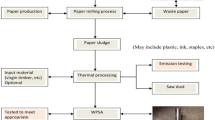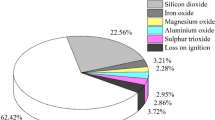Abstract
The viability of combining waste slag produced from steel (Basic Oxygen furnace) and iron (Blast Furnace) industry as replacement of cement in cement mortars was investigated. The impacts on the normal consistency, setting times, soundness, compressive strength, microstructure, and durability of cement paste/mortar were studied. The results revealed that the water requirement and the setting time of cement paste increased by the addition of steel slag powder. The optimum content of steel slag and GGBS (ground granulated blast furnace slag) as a combined admixture was 40%. The 28 day compressive strength was comparable, whereas it exceeded the strength of control mortar after 90 days of curing. The microstructure of samples was studied using SEM micrographs, which indicated denser structures of ternary mortars. The durability tests of accelerated carbonation, sulphuric acid resistance, and electrical resistivity showed acceptable results. Life cycle assessment (LCA) of ternary mortar indicated visible decrease in environmental impacts in all categories. Response Surface Methodology (RSM) was adopted to find relation between partial replacement of cement by steel slag and GGBS in ternary blend and compressive strength. This research bestows a new understanding of how industrial wastes can be managed sustainably with imparting additional benefits to the concrete economically.










Similar content being viewed by others
References
IBM (2017) Indian Minerals Yearbook 2017 Slag-Iron and Steel (Advance Release) Government of India Ministry of Mines Indian Bureau of Mines 16 Slag-Iron and Steel, New Delhi. http://ibm.gov.in/writereaddata/files/12142018183814Slagironandsteel%202017.pdf
Ministry of Steel, Government of India (2017) An overview of steel sector, pp 1–5. http://steel.gov.in/overview-steel-sector
Federation of Indian Chambers of Commerce and Industry (2014) Using Steel slag in infrastructure development, FICCI Blog, pp 1–8. http://blog.ficci.com/steel-slag/5291/
Sakai S et al (2011) International comparative study of 3R and waste management policy developments. J Mater Cycles Waste Manag 13(2):86–102
Ulubeyli GC, Artir R (2015) Sustainability for blast furnace slag: use of some construction wastes. Proc Soc Behav Sci 195:2191–2198
Siddique R (2014) Utilization (recycling) of iron and steel industry by-product (GGBS) in concrete: strength and durability properties. J Mater Cycles Waste Manag 16(3):460–467
Babu KG, Kumar VSR (2000) Efficiency of GGBS in concrete. Cem Concr Res 30(7):1031–1036
Qiang W, Mengxiao S, Jun Y (2016) Influence of classified steel slag with particle sizes smaller than 20 l m on the properties of cement and concrete. Constr Build Mater 123:601–610
Rondi L, Bregoli G, Sorlini S, Cominoli L, Collivignarelli C, Plizzari G (2016) Concrete with EAF steel slag as aggregate: a comprehensive technical and environmental characterisation. Compos Part B Eng 90:195–202
Wang Q, Zhang B, Yan P (2013) The influence of steel slag with high Al2O3 content on the initial hydration of cement. Sci China Technol Sci 56(12):3123–3128
Shi Y, Chen H, Wang J, Feng Q (2015) Preliminary investigation on the pozzolanic activity of superfine steel slag. Constr Build Mater 82:227–234
Li Z, Zhao S, Zhao X, He T (2013) Cementitious property modification of basic oxygen furnace steel slag. Constr Build Mater 48:575–579
Caijun S (2004) Steel slag—its production, processing, characteristics, and cementitious properties. J Mater Civ Eng 16(3):230–236
Tsakiridis PE, Papadimitriou GD, Tsivilis S, Koroneos C (2008) Utilization of steel slag for Portland cement clinker production. J Hazard Mater 152(2):805–811
Wang Q, Yan PY, Han S (2011) The influence of steel slag on the hydration of cement during the hydration process of complex binder. Sci China Technol Sci 54(2):388–394
Liu S, Li L (2014) Influence of fineness on the cementitious properties of steel slag. J Therm Anal Calorim 117:629–634
Zhang T-SS, Liu F-TT, Liu S-QQ, Zhou Z-HH, Cheng X (2008) Factors influencing the properties of a steel slag composite cement. Adv Cem Res 20(4):145–150
Lizarazo-Marriaga J, Claisse P, Ganjian E (2011) Effect of steel slag and portland cement in the rate of hydration and strength of blast furnace slag pastes. J Mater Civ Eng 23(2):153–160
Tsai C, Huang R, Lin W, Chiang H (2014) Using GGBOS as the alkali activators in GGBS and GGBOS blended cements. Constr Build Mater 70:501–507
Aguiar JB, Júnior C (2013) Carbonation of surface protected concrete. Constr Build Mater 49:478–483
Sideris KK, Tassos C, Chatzopoulos A, Manita P (2018) Mechanical characteristics and durability of self compacting concretes produced with ladle furnace slag. Constr Build Mater 170:660–667
Lye C (2016) Carbonation resistance of GGBS concrete. Mag Concr Res 68(18):936–969
Miyahara S, Owaki E, Ogino M, Sakai E (2017) Carbonation of a concrete using a large amount of blast furnace slag powder. J Ceram Soc Jpn 125(6):533–538
Özbay E, Erdemir M, Durmuş HI (2016) Utilization and efficiency of ground granulated blast furnace slag on concrete properties—a review. Constr Build Mater 105:423–434
He Z, Yang H, Shao Y, Liu M (2013) Early carbonation behaviour of no-clinker steel slag binder. Adv Cem Res 25(6):342–351
ACI Committee 222 (2001) Protection of metals in concrete against corrosion, ACI 222R-01, pp 1–41. https://www.concrete.org/publications/internationalconcreteabstractsportal/m/details/id/11305
Lübeck A, Gastaldini ALGG, Barin DS, Siqueira HC (2012) Compressive strength and electrical properties of concrete with white Portland cement and blast-furnace slag. Cem Concr Compos 34(3):392–399
Shubbar AA, Jafer H, Dulaimi A, Hashim K, Atherton W, Sadique M (2018) The development of a low carbon binder produced from the ternary blending of cement, ground granulated blast furnace slag and high calcium fly ash: an experimental and statistical approach. Constr Build Mater 187:1051–1060
Hornbostel K, Larsen CK, Geiker MR (2013) Relationship between concrete resistivity and corrosion rate—a literature review. Cem Concr Compos 39:60–72
Adamson A et al (2012) Influence of different European cements on the hydration of cover-zone concrete during the curing and postcuring periods. J Mater Civ Eng 25(9):1335–1343
Ondová M, Vaclavik V (2015) Environmental assessment of the concrete based on blast furnace slag. Solid State Phenom 244:213–220
Bureau of Indian Standards (2013) Ordinary portland cement, 43 grade-specification, second revision, IS 8112
Mason B (1944) The constitution of some basic open-hearth slags. J Iron Steel Ind 11:69–80
IS 5513 (1996) Vicat apparatus—specification. Bureau of Indian Standards, 1996
Bureau of Indian Standards (1996) Apparatus used in ‘le- chatelier’ test- specification, IS 5514
ASTM C 642-13 (2013) Standard test method for density, absorption, and voids in hardened concrete, ASTM International, West Conshohocken, PA. www.astm.org. Accessed 12 May 2019
ASTM C 1202 (2019) Standard test method for electrical indication of concrete’s ability to resist chloride ion penetration, ASTM International, West Conshohocken, PA. www.astm.org. Accessed 14 May 2019
Vijay K, Murmu M (2019) Effect of calcium lactate on compressive strength and self-healing of cracks in microbial concrete. Front Struct Civ Eng 13(3):515–525. https://doi.org/10.1007/s11709-018-0494-2
ISO, International Standardisation Organisation (2006) ISO 14040: environmental management life cycle assessment—principles and framework; ISO 14040. International Standardisation Organisation. https://www.iso.org/standard/37456.html
ISO, International Standardisation Organisation (2006) ISO 14044: environmental management life cycle assessment—requirements and guidelines; ISO 14044. International Standardisation Organisation. https://www.iso.org/standard/38498.html
Zhu J, Zhong Q, Chen G, Li D (2012) Effect of particle size of blast furnace slag on properties of portland cement. Proc Eng 27(2011):231–236
IS (1988) 4031(part 3), methods of physical test for hydraulic cement, part 3-determination of soundness. Bureau of Indian Standards
Cho B, Choi H (2016) Physical and chemical properties of concrete using GGBFS-KR. Constr Build Mater 123:436–443
Divsholi BS, Lim TYD, Teng S (2014) Durability properties and microstructure of ground granulated blast furnace slag cement concrete. Int J Concr Struct Mater 8(2):157–164
Mo L, Zhang F, Deng M (2016) Mechanical performance and microstructure of the calcium carbonate binders produced by carbonating steel slag paste under CO2 curing. Cem Concr Res 88:217–226
Sengul O (2014) Use of electrical resistivity as an indicator for durability. Constr Build Mater 73:434–441
Ganesh P, Murthy AR (2019) Tensile behaviour and durability aspects of sustainable ultra-high performance concrete incorporated with GGBS as cementitious material. Constr Build Mater 197:667–680
Duan W, Yu Q, Wang Z, Liu J, Qin Q (2018) Life cycle and economic assessment of multi-stage blast furnace slag waste heat recovery system. Energy 142:486–495
Menéndez G, Bonavetti V, Irassar EF (2003) Strength development of ternary blended cement with limestone filler and blast-furnace slag. Cem Concr Compos 25(1):61–67
Hosseini SV, Eilbeigi S, Nilforoushan MR (2016) Effects of three types of iron and steel slag on fresh. In: Advances in molten slags, fluxes, and salts: proceedings of the 10th international conference on molten slags, fluxes and salts, pp 837–846
Acknowledgments
The suggestions/comments of the reviewer have been highly appreciated and the same has been incorporated in the manuscript.
Author information
Authors and Affiliations
Corresponding author
Additional information
Publisher's Note
Springer Nature remains neutral with regard to jurisdictional claims in published maps and institutional affiliations.
Rights and permissions
About this article
Cite this article
Palod, R., Deo, S.V. & Ramtekkar, G.D. Utilization of waste from steel and iron industry as replacement of cement in mortars. J Mater Cycles Waste Manag 21, 1361–1375 (2019). https://doi.org/10.1007/s10163-019-00889-3
Received:
Accepted:
Published:
Issue Date:
DOI: https://doi.org/10.1007/s10163-019-00889-3




